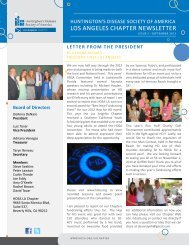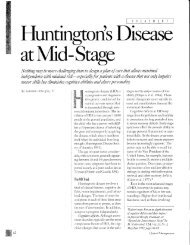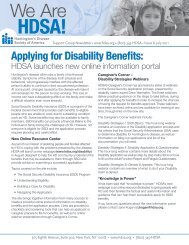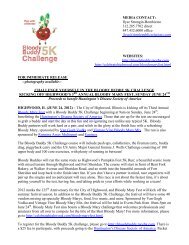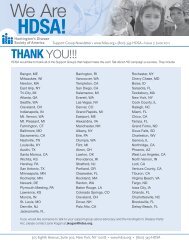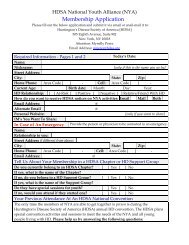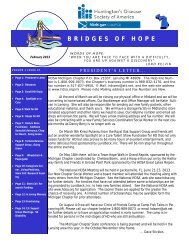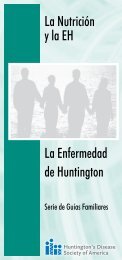The Marker - 2004 - Huntington's Disease Society of America
The Marker - 2004 - Huntington's Disease Society of America
The Marker - 2004 - Huntington's Disease Society of America
Create successful ePaper yourself
Turn your PDF publications into a flip-book with our unique Google optimized e-Paper software.
esearch<br />
grants & fellowships<br />
HDSA GRANT AND FELLOWSHIP RECIPIENTS 2003–<strong>2004</strong><br />
Though the HDSA Coalition for the<br />
Cure serves as the flagship <strong>of</strong> HDSA’s<br />
research program, HDSA’s prestigious<br />
Grant and Fellowship program has<br />
contributed significantly to advancing<br />
our knowledge about HD and the<br />
disease process.<br />
<strong>The</strong> Grant and Fellowship program<br />
provides essential funding to research<br />
projects in their early stages <strong>of</strong><br />
development. This “seed money” allows<br />
HDSA Grant recipients to generate<br />
sufficient data and advance their project<br />
from a promising hypothesis to a mature<br />
study that will then be eligible for greater<br />
funding from larger national agencies<br />
like the National Institutes <strong>of</strong> Health<br />
(NIH) or the National Institute <strong>of</strong><br />
Neurological Disorders and Stroke<br />
(NINDS). <strong>The</strong> HDSA Grant program<br />
provides grants <strong>of</strong> up to $100,000<br />
(payable over two years if renewed).<br />
HDSA Fellowships were created to<br />
expand the pool <strong>of</strong> young researchers<br />
who are interested in studying HD.<br />
HDSA Fellowship awards can total<br />
up to $80,000 (payable over two<br />
years if renewed).<br />
<strong>The</strong>rapeutic Initiative awards are special<br />
grants that fund research projects that<br />
will develop assays (tests) to look at<br />
various promising compounds and drugs<br />
that might yield an effective treatment<br />
for HD. <strong>The</strong> HDSA <strong>The</strong>rapeutic<br />
Initiative grant program will soon be<br />
expanded into the HDSA Drug<br />
Discovery Team – a collaborative that<br />
will pursue partnerships with industry to<br />
develop therapeutic remedies for HD.<br />
New Grants 2003–<strong>2004</strong><br />
Ilya Bezprozvanny, Ph.D.<br />
University <strong>of</strong> Texas Southwestern<br />
Medical Center<br />
Dallas, TX<br />
Association <strong>of</strong> Inositol-(1.4.5)<br />
Triphosphate Receptor with HAP1<br />
and Huntingtin Proteins in the Brain:<br />
Implications for Huntington’s<br />
<strong>Disease</strong><br />
It appears that huntingtin-associated<br />
protein-1 (HAP1), which binds with<br />
huntingtin, interacts with a calciumrelease<br />
channel, in yeast. Calcium<br />
gradients affect a cell’s ability to<br />
produce usable energy and Huntington’s<br />
<strong>Disease</strong> seems to be related to this<br />
misfunction. Dr. Bezprozvanny is thus<br />
investigating the relationship between<br />
the calcium channel, HAP1, and<br />
huntingtin (protein) to determine how<br />
alterations may contribute to and impair<br />
<strong>Huntington's</strong> <strong>Disease</strong>.<br />
Pamela J. Bjorkman, Ph.D.<br />
California Institute <strong>of</strong> Technology<br />
Pasadena, CA<br />
Structural and Binding Studies <strong>of</strong><br />
Mono-, Bi-, and Trivalent Anti-Poly-<br />
Gln Antibodies Bound to Huntingtin<br />
Exon1<br />
Mutant huntingtin protein aggregates<br />
and forms large clusters within the<br />
nucleus <strong>of</strong> HD cells. Dr. Bjorkman is<br />
investigating the potential to physically<br />
block this interaction using a variety <strong>of</strong><br />
reagents that are targeted to multiple<br />
binding sites on mutated huntingtin.<br />
Janet Dubinsky, Ph.D.<br />
University <strong>of</strong> Minnesota<br />
Minneapolis, MN<br />
Proteomics <strong>of</strong> CNS Mitochondria<br />
Inhibitors <strong>of</strong> mitochondria, the energy<br />
factory within a cell, mimic the<br />
pathology <strong>of</strong> HD, suggesting<br />
mitochondrial disorder may contribute<br />
to Huntington’s <strong>Disease</strong>. Recently, Dr.<br />
Dubinsky discovered that mitochondria<br />
in the striatum, the region <strong>of</strong> the brain<br />
most affected in HD, are more at risk <strong>of</strong><br />
disruption. She now examines the<br />
protein pr<strong>of</strong>ile for both cortical and<br />
striatal mitochondria in the hopes <strong>of</strong><br />
identifying a factor unique to striatal<br />
cells that may provide a target for<br />
therapeutic treatments.<br />
Pietro Mazzoni, M.D., Ph.D.<br />
Columbia University<br />
New York, NY<br />
Impairment <strong>of</strong> Motor Learning as a<br />
Biologic <strong>Marker</strong> <strong>of</strong> Pre-symptomatic<br />
Huntington’s <strong>Disease</strong><br />
Currently, when patients are diagnosed<br />
with neurodegeneration, a great deal <strong>of</strong><br />
brain damage has already occurred.<br />
Better exams, such as those being<br />
designed by Dr. Mazzoni, are therefore<br />
necessary so that once neuroprotective<br />
treatments are discovered, they may be<br />
administered as early as possible to<br />
avoid extensive neurodegeneration.<br />
4



